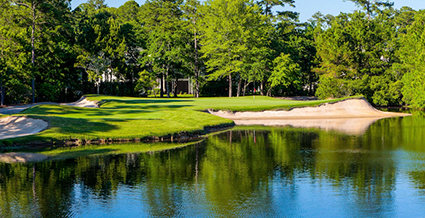Late for a Tee Time With Raymond Floyd and Other Sweet Memories of Arrowhead Country Club
 I missed my tee time with Raymond Floyd, chased the PGA Tour legend down on the first green and double-hit a chip shot in front of a few dozen people.
I missed my tee time with Raymond Floyd, chased the PGA Tour legend down on the first green and double-hit a chip shot in front of a few dozen people.
Those are some of my memories from my first round at Arrowhead Country Club, designed by noted South Carolina architect Tom Jackson with signature input from Floyd.
But almost 20 years later, I have beautiful memories of the challenging course, a water-filled, 27-hole layout along the Intracoastal Waterway only a few minutes from the heart of Myrtle Beach. I’ve had the good fortune to play it several times since my scrambling introduction in November 1994.
Here’s how my round began: I raced out of my car, ran up to the first tee, hurriedly knocked a drive into the left rough then leaped out of my golf cart to hit three more ugly shots before reaching the green to join my playing partner, Floyd, who didn’t seem at all amused.
Let me explain. As sports editor of The Sun News, Myrtle Beach’s daily newspaper, I had the good fortune to receive an invitation from Arrowhead ownership to join Floyd for golf on the Lakes nine at the grand opening. Arrowhead, which opened with 18 holes, opened a third nine soon after.
Nice perk, right? Of course. And the timing was perfect for Arrowhead and Floyd, who was in town for the Senior Tour Championship at The Dunes Golf and Beach Club, which would begin the next day.
It wasn’t so good for me, who was pretty much working around the clock, putting together the newspaper’s fat, special section on the tournament and planning additional 32-pagers after each of the four rounds. I got called into a meeting at the office just when I had planned to leave with a little time to spare for my round at Arrowhead.
Fortunately, I settled down from there and made seven pars to go along with an embarrassing T.C. Chen moment at a par-3 (either No. 5 or No. 8) when I double-hit a chip and made a second double-bogey. OK, I do remember hitting one well-struck draw off the tee on a dogleg left. I shot 40. Pretty good for a sports writer, to paraphrase Floyd, as I hustled back to my car to go back to work.
That’s about all I remember from a frantic, though enjoyable, day.
Playing with a harried sports writer the day before the tournament didn’t appear to have any negative impact on Floyd’s game – he won the season-ending tournament, outlasting Jim Albus in a five-hole playoff. Floyd was patient playing with me and patient in the playoff.
Anyway, below are three holes – one on each nine – you won’t forget after a round at Arrowhead. One last tip: try to get to the course with enough time to register in the pro shop and walk leisurely to the first tee.
No. 3 Lakes, 556 yards, par-5: This is a par-5 where 5 is a great score. A thin lagoon extends down the entire left side just off the fairway then crosses in front of the green. Big hitters can go for the green over the water, but there’s little margin for error. Taking the safer, three-shot route, which finishes with a tricky approach to the left over the water, isn’t easy, either.
No. 4 Cypress: 355 yards, par-4: A fun, short hole that requires two tests of nerves. The short tee shot must be hit accurately to the left of two pot bunkers and a small river that branches off the nearby Intracoastal Waterway to set up an approach – framed by a view of the Waterway – back over the water to a small, undulating green surrounded by four bunkers.
No. 5 Waterway, 387 yards, par-4: The Waterway stretches down the entire left side of the hole, one of only a handful of holes on the Grand Strand that feature the Waterway as a hazard. Bunkers on the left and right frame a generous fairway. The diagonally shaped green is protected by four bunkers, three In front and one behind.
Read MoreYour Very Unofficial Big Break Myrtle Beach Postseason Awards
Now that the final putt has dropped on Big Break Myrtle Beach, we can look back on the 11-episode season that produced outstanding golf, questionable decisions, heartbreak and good TV.
Here are our very unofficial post-show awards!
Read MoreEpisode 11 Recap: Gritty Jimmy Brandt Crowned Champion of Big Break Myrtle Beach
A season that began with the possibility of a life-changing opportunity for 12 aspiring professional golfers was reduced to a pair, Jimmy and Toph, who seemed to have developed as genuine a friendship as a reality show will allow.
That dynamic made the show’s traditional opening at the breakfast table all the more awkward as they prepared to compete for the opportunity to win Big Break Myrtle Beach, and the more than $100,000 in cash and prizes that awaited the winner.
Read MoreGolf Instruction Zone Video: The Magic of the Right Arm
Classic Swing Golf School’s Ted Frick explains how the fundamentals of throwing a punch can help improve your swing in a tip that highlights the importance of the right arm in generating power in your golf swing.
Read MoreBig Break Myrtle Beach Championship Match Preview
After nearly three months of great golf, stunning eliminations and, of course, heartbreak, we’ve reached the finale of Big Break Myrtle Beach. Jimmy and Toph have survived multiple elimination challenges, but only one will claim the mantle of Big Break Myrtle Beach champion and earn the bounty that awaits the winner. While you are awaiting the finale, which will air Tuesday night at 9 p.m. on Golf Channel, enjoy a quick primer! Extra: Jimmy vs. Toph By The Numbers
Read MoreBig Break Myrtle Beach Finale: Jimmy vs. Toph By The Numbers
Jimmy vs. Toph.
It’s winner take all on the finale of Big Break Myrtle Beach.
Here is a look at the championship match by the numbers:
Read MoreStanding the Test of Time, Wild Wing Avocet Remains One of Myrtle Beach’s Best
 How good is Wild Wing’s Avocet golf course? Two decades after the grand opening, I still have the poster given out at the party featuring player/architect Larry Nelson and a photo of the course hanging on a wall at home.
How good is Wild Wing’s Avocet golf course? Two decades after the grand opening, I still have the poster given out at the party featuring player/architect Larry Nelson and a photo of the course hanging on a wall at home.
OK, there are several better reasons – I also have a poster of Moe, Larry and Curly preparing to hit the links and another of four dogs playing poker – to recognize Avocet.
For starters, Avocet survived while its three Wild Wing siblings, each deserving of reputations as among the Strand’s best manicured layouts, were replaced by a housing development.
Has it really been more than 20 years since Nelson, only six years removed from winning his second PGA Championship (he also won the 1983 U.S. Open), was on-site for the grand opening?
Yes, Avocet has stood the test of time.
Third to open behind Wood Stork and Hummingbird, Avocet immediately became the players’ favorite at the upscale Wild Wing complex, and remained so after completion of Falcon.
Designed by Jeff Brauer, the interesting Avocet layout tests golfers with a good mix of holes finishing on smooth miniverde putting surfaces. Hazards and challenges include creeks, lagoons, pot bunkers, grass bunkers, greenside swales, alternate landing areas and tiered putting surfaces.
Alone on the former 72-hole development, Avocet may fly under the radar for many visiting golfers, but it’s an enjoyable challenge for players of all levels.
A few holes (distances from the back tees) to remember from a round at Avocet:
- The 462-yard sixth may be as difficult as any par-4 hole on the Grand Strand. A lagoon stretches along the entire left side of the hole, which finishes with a three-tiered green. Trees along the right off the tee and a huge bunker short and right of the green make bailout shots risky, too. The vast double green is shared by No. 17.
- The 362-yard ninth is one of the most fun at the beach. Players can aim either right or left (for those of us directionally challenged, hit it straight and take advantage of poor execution) of a grassy strip with a handful of pot bunkers to two fairway landing areas. There are no bunkers to challenge the remaining short approach, but a “Valley of Sin” dip on the front left of the green makes par difficult from that area.
- The 227-yard 12th is one of the most unique par-3s you’ll ever play. Guarded by a vast front bunker, the best option is to go long – maybe too long – with a wood. Taking that tactic, players can use a grassy bank as a backboard to ricochet shots backward onto the green.
 John Brasier covered Grand Strand golf as golf writer and sports editor of The Sun News in Myrtle Beach. He also has written about Grand Strand golf for several national publications, including Golf Magazine, Golfweek and GolfWorld. A mid-handicapper with a history of luck on short holes, he’s made four holes-in-one, though much to his regret, none on the Grand Strand.
John Brasier covered Grand Strand golf as golf writer and sports editor of The Sun News in Myrtle Beach. He also has written about Grand Strand golf for several national publications, including Golf Magazine, Golfweek and GolfWorld. A mid-handicapper with a history of luck on short holes, he’s made four holes-in-one, though much to his regret, none on the Grand Strand.
Drama, Heartbreak Aplenty on 10th Episode of Big Break Myrtle Beach
It was semifinal Tuesday on Big Break Myrtle Beach, and the episode delivered the expected drama as Anthony, Emily, Jimmy and Toph battled for a coveted spot in the show finale.
After the obligatory breakfast table talk, Emily opened a letter that informed players that their first swing of the day might be their most important.
Read MoreEpisode 10 Preview: Double Elimination Tuesday on Big Break Myrtle Beach
We’ve reached semifinal Tuesday as Big Break Myrtle Beach nears its conclusion. Four gifted players – Anthony, Emily, Jimmy and Toph – remain but talent alone won’t be enough. Two contestants will go home this week. Who will have the nerve and good fortune to advance to next week’s finale? Tune in to Golf Channel Tuesday at 9 p.m. to find out. In the meantime, enjoy the episode 10 preview.
Read MoreFond Memories: Lion’s Paw Launched Ocean Ridge Plantation, Tim Cate
 For me, November always brings back memories of Lion’s Paw Golf Links, a course of historic importance for at least two major reasons:
For me, November always brings back memories of Lion’s Paw Golf Links, a course of historic importance for at least two major reasons:
• Lion’s Paw served as the catalyst for launching the solo career of Tim Cate, now one of the Grand Strand’s most prolific and celebrated course designers.
• Lion’s Paw helped launch the wildly successful, 72-hole Ocean Ridge Plantation development along U.S. 17 near Sunset Beach.
Why November? Simple. It was a beautiful November day in 1991 when I played Lion’s Paw for the first time soon after it opened.
I don’t know if many golfers do this, but I always seem to remember the month when I played a golf course for the first time. Maybe it because a golf course often takes on different personalities depending on the time of the year. You remember the bright morning sun in the spring and the spectacular color of the leaves in the fall.
Lion’s Paw was an instant hit featuring an interesting mix of holes, including two distinctively different nines, superb playing conditions and sparking white bunkers (it was a Grand Strand pioneer in using bright white sand in bunkers). Oh yeah, despite the beauty, the course isn’t overly difficult. There are reachable par-5s and some very playable par-4s, too.
When you play Lion’s Paw, you may notice on the scorecard that Willard Byrd is the architect of record. That’s true, but Cate was on site throughout the project, and his work prompted Ocean Ridge developers to hire him for the remaining 54 holes, and also drew the attention of several other North Strand developers.
Cate’s other solo projects along the southern coast of North Carolina include The Thistle, where wind as well as water and sand serves as an obstacle.
No other golf architect has so many courses concentrated in one portion of the Grand Strand. If you want to play a Cate solo design near Myrtle Beach, you have to play in Brunswick County, N.C.
After completing Panther’s Run, the second Ocean Ridge layout, Cate designed The Thistle before returning to finish Tiger’s Eye and Leopard’s Chase.
Cate’s success at Panther’s Run led to bigger budgets and more lavish layouts at Tiger’s Eye, Leopard’s Chase and The Thistle, which each have received mention on lists of the Grand Strand’s top courses.
Cate showed his versatility at Lion’s Paw, carving beautiful holes through forest on the front nine then allowing wind and water to provide the major challenges on a largely open back side.
So what caught developers’ eyes at Lion’s Paw? There are a lot of great holes. But this trio of unique, watery par-3s really stands out:
-No. 3, 204 yards: The approach (178 yards from the white tees) is all carry over a lake and the thin boundary of sand that lines the water to a diagonally shaped green guarded in back and to the right by an “S” shaped bunker and three pot bunkers.
-No. 6, 225 yards (175 yards whites): Another great par-3 requiring mostly carry over water to an undulating, somewhat triangular green framed by mounding. A pair of spacious bunkers guard the front, but there’s bailout room to the left.
-No. 17, 185 yards (154 yards whites): Players hit down a peninsula to a green surrounded by a horseshoe-shaped body of water. A spacious bunker guards the front left. Cate left a little room off the edges of the putting surfaces to allow near-misses to stay dry. Strong breezes are often a tremendous factor on the tee shot.
 John Brasier covered Grand Strand golf as golf writer and sports editor of The Sun News in Myrtle Beach. He also has written about Grand Strand golf for several national publications, including Golf Magazine, Golfweek and GolfWorld. A mid-handicapper with a history of luck on short holes, he’s made four holes-in-one, though much to his regret, none on the Grand Strand.
John Brasier covered Grand Strand golf as golf writer and sports editor of The Sun News in Myrtle Beach. He also has written about Grand Strand golf for several national publications, including Golf Magazine, Golfweek and GolfWorld. A mid-handicapper with a history of luck on short holes, he’s made four holes-in-one, though much to his regret, none on the Grand Strand.
Big Break Myrtle Beach Episode 9 Recap: The $10,000 Question is Answered
Two things were guaranteed to happen in episode 9 of Big Break Myrtle Beach. Most importantly, the semifinals were going to be set, and secondarily, we were going to find out whether Charlie would earn $10,000 by advancing to the semifinals without using the super immunity he earned in the opening episode.
The five remaining contestants went to the sixth hole on the Love Course at Barefoot Resort for the opening immunity challenge. There were four hitting locations on the hole – a 100-foot putt, a downhill chip, a chip over a retaining wall, and a 100-yard shot. The players closest to the hole on the first three locations advanced to the fourth were the winner would secure immunity and a trip to the semifinals.
Emily, Jimmy and Toph advanced to the 100-yard shot in the battle for immunity.
Emily, who has played exceedingly well the last two weeks, put her ball to 4’2” to earn her trip to the semifinals.
The second immunity provided three locations – a 7-foot putt, 160 yards from the pin, and 230 yards out. The four remaining players Anthony, Charlie, Jimmy and Toph played the hole out from each of the three locations. Lowest score earned immunity, highest went straight to elimination.
Anthony and Charlie both made their putts on the opening location while Jimmy and Toph missed, turning the challenge into a pair of two-person matches. Anthony and Charlie battled for immunity while Toph and Jimmy sought to avoid going straight to elimination. Both “matches” came down to the final location.
From 230 yards out, Anthony and Charlie were both…
Read MoreBig Break Episode 9 Preview: Final Four to be Set!
Only two episodes remain before the season finale, and the final four will be determined in this week’s drama-filled episode. Will Charlie hold on to the Super Immunity he won in the first episode and collect $10,000? Will the brash Anthony continue to advance? Those are but a few of the questions that will be answered Tuesday night at 9 p.m. on Golf Channel. Enjoy a preview of the ninth episode of Big Break Myrtle Beach.
Read MoreCarolinas PGA Section Honors Head Pros at True Blue, Caledonia
 The list of honors for Caledonia and True Blue, two of America’s top 100 public courses, just got a little longer.
The list of honors for Caledonia and True Blue, two of America’s top 100 public courses, just got a little longer.
Bart Romano, the head professional at True Blue, was named The Carolinas PGA Section 2014 Merchandiser of the Year in the Resort Course Category.
Caledonia’s head pro, Marc Guertin, was named CPGA Merchandiser of the Year in the Public Course Category as well.
“We are grateful that The Carolinas PGA Section has recognized Bart and Marc as Merchandisers of the Year in their respective categories,” said Bob Seganti, PGA Director of Golf Operations at Caledonia and True Blue. “I know that both men appreciate their vendor relationships, fellow staff members and most importantly the customers who support the brands. To have their efforts recognized by the Carolinas PGA is a nice way to start the Holiday season.”
By virtue of winning the Carolinas Section awards, Romano and Guertin will be nominated for national Merchandiser of the Year honors.
The awards are another in a steady stream for Caledonia and True Blue, both Mike Strantz designs. Golf Magazine ranked Caledonia 27th and True Blue 77th on its prestigious list of the Top 100 You Can Play, a ranking of the nation’s best public courses that was released in September 2014.
Golfweek also ranked Caledonia the 24th best resort course in America in its recently released Ultimate Guide to Golf Course Living and Great Escapes.
Routed along a stunning piece of property, Caledonia is equal parts art and architecture. Strantz carved a masterpiece between soaring live oak trees draped in Spanish moss and alligator-filled, lowcountry water that used to feed a thriving rice plantation.
Everything about True Blue, a 7,126-yard monster, is big, including the fairways, greens and waste bunkers.
Golf Magazine said of True Blue, “Hole to hole, the variety is astounding. The course is mostly open, with beauty and menace mingling with lakes, marshland and plenty of scrub-filled natural sandy areas … Rarely has golf architecture had a shaper as artful as Strantz. The full measure of his formidable skill is on display at True Blue.”
Read MoreBig Break Myrtle Beach Episode 8 Recap: Charlie Flirts With Danger
Big Break Myrtle Beach returned to Barefoot Resort and with just six players remaining, everyone’s margin for error is razor thin, something that’s not lost on the contestants.
The first immunity challenge, which took place at the Dye Course, required players to hit the ball through what amounted to a Big Break frame approximately 35 yards from the pin.
Read MoreCaddie Chronicles: From Augusta to Azerbaijan, Our Man Duncan Brings 2014 to a Close
 I think it’s safe to say that my 2014 season has come to a close. A tour caddie that is supposed to be retired, I still worked ten tournaments this year. That may be a little more than I planned or wanted to do, but I have to admit, I enjoyed every one of them.
I think it’s safe to say that my 2014 season has come to a close. A tour caddie that is supposed to be retired, I still worked ten tournaments this year. That may be a little more than I planned or wanted to do, but I have to admit, I enjoyed every one of them.
From getting kicked out of The Masters (something I'm actually quite proud of) to being part of winning the silver medal with Matt Fitzpatrick at the US Open to working for my old boss, Johan Edfors, in far flung Azerbaijan, to working this week at the only PGA event in Mexico, all of them have been great. The problem with retiring from 30 plus years of being a tour caddie is all your friends are on tour and you end up never getting to see any of them. These few weeks back out gave me the opportunity to catch up with all my mates.
Wouldn't have missed that for anything.
The week in Mexico was particularly enjoyable for me as I always enjoy doing the unusual events, and I think a PGA Tour event being held in Mexico falls into that category.
It was also quite nice because I was working for a new player for me. In this caddying world, we tend to end up in certain “stables.” Taking me as an example, I've worked for 22 different Swedes in my career. You do a good job on the bag for one of them and the next thing you know you've gone through the whole stable of them.
I've also bagged for quite a few Spaniards, and this week I got an opportunity to work for a big name player, Gonzalo Fernández-Castaño (you have to admit, that's a big name!). How I ended up on the bag was sort of interesting as well.
After working for Matt Fitzpatrick at the French Open, Matt's management group decided since I wasn't caddying fulltime anymore they needed to get someone else on that bag, and I went back to looping for Johan Edfors.
A few weeks went by when I got a call from Matt saying he wasn't getting on so well with his new caddie and would I come out and work for him at the Dutch Open. This was great news for me as the Dutch Open is one of my favorite weeks on tour. The tournament was being held at Kennemer Golf Course, which is arguably one of the best courses on continental Europe. It's a Harry Colt designed layout and if you ever get a chance to play it, don't pass it up.
Well, as it turned out Matt and I had the locker right next to Gonzalo. One afternoon I got back to the locker in time to hear Gonzalo's caddie telling him that he really didn't fancy flying all the way from China to Mexico and then flying all the way back to Japan. I gave his caddie a little nudge in the ribs and told him I would be more than happy to do that week for him.
We had a laugh and nothing more was said about it. But three weeks later I got an email from Gonzalo asking me if I was available to bag for him the week of the Mayakoba? Great, I was back in the Spanish stable!
I've actually done this tournament twice before when it was just a Web.com event. As coincidence would have it, I also worked that week for a Spanish player, Alejandro Canizares, who's the son of the legendary Spanish golfer, Jose Canizares. In a lazy sort of way, it is always nice to come…
Read More